The Fundamental Unit of Life
"Cell is the structural and functional unit of living organisms."
1.0Introduction
Cell is the basic structural and functional unit of living organisms. Cell biology is branch of biology that deals with the study of cell in all respect of its structure and function.
2.0Discovery of cell
(i) Robert Hooke (1665) observed dead cell which resembled honeycomb like structures in cork (comes from bark of tree). He called these boxes 'cell'. He published what he observed under his self-designed microscope (primitive microscope) in his book 'Micrographia'. (ii) Anton Van Leeuwenhoek (1674) was first to discovered free living cell in pond water with improved microscope. (iii) Robert Brown (1831) discovered the nucleus in cell. (iv) Dujardin (1835) discovered living fluid substance of cell and named Sarcode. (v) J. E. Purkinje (1839) coined the term protoplasm for the fluid substances of the cell. It is living matter present inside the cell. (vi) Huxley (1868) called protoplasm "The physical basis of life". (vii) Rudolf Virchow (1855) - German pathologist established that all cells arise from preexisting cells ("omnis cellula e cellula").
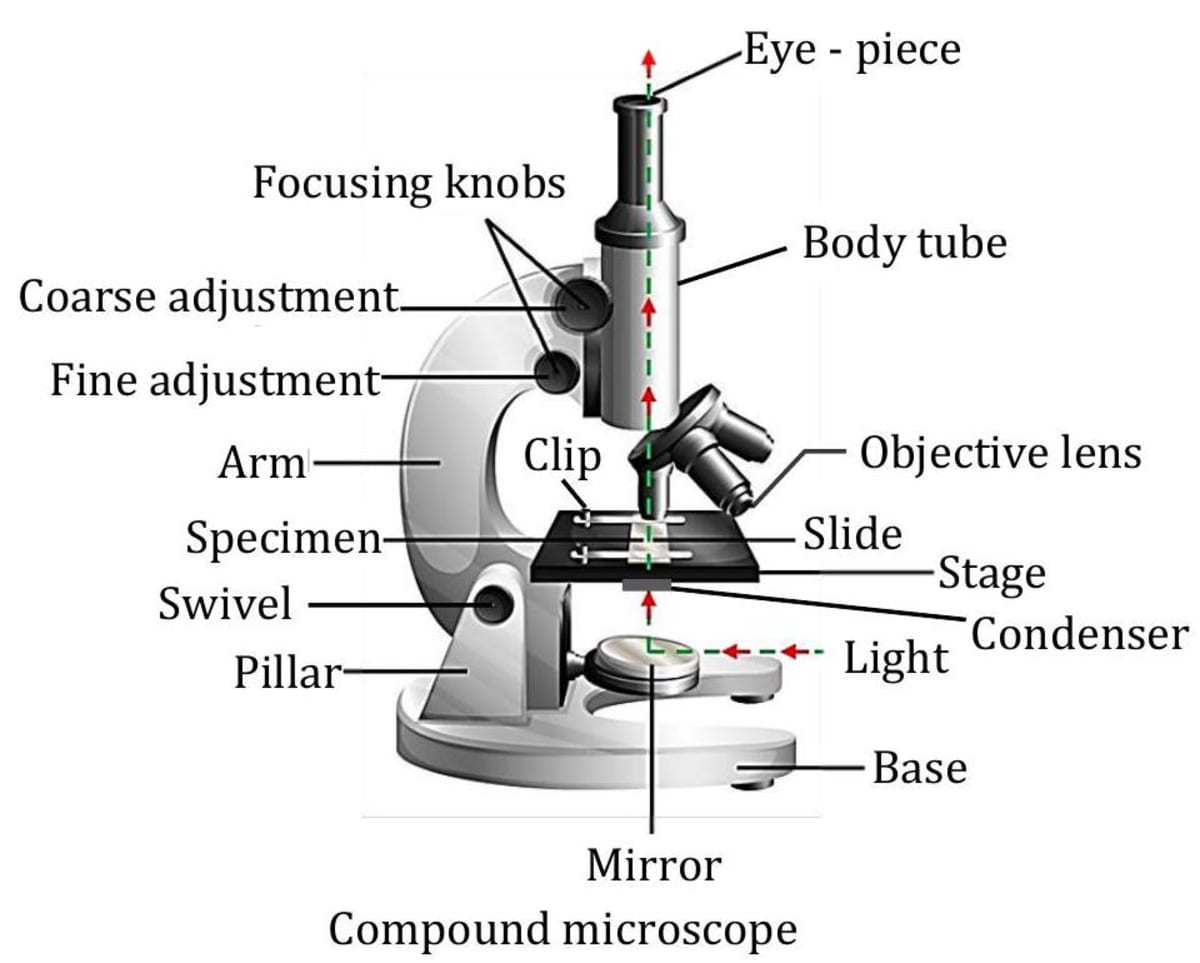
- A compound microscope is an optical instrument for forming magnified images of small objects consisting of an object lens and an eye piece, both lenses mounted in the same tube.
- The discovery of electron microscope by Knoll and Ruska, in 1939 made it possible to observe and understand the complex structure of cell and its organelles.
3.0Cell Theory
The "cell theory" was formulated by two biologists, M.J. Schleiden (1838), and T. Schwann (1839). According to them, all the plants and animals are composed of cells and that the cell is the basic unit of life. The cell theory was further expanded by Virchow (1855) by suggesting that all cells arise from pre-existing cells.
Cell theory, states that
(i) All living organisms are composed of cells and products of cells. (ii) All cells arise from pre-existing cells.
Size of cell:
Normal size of human cell - to in diameter. (i) Largest isolated single cell in animals is an Ostrich egg. (ii) Longest cell in animals is Nerve cell. (iii) Smallest cell is PPLO-Pleuro Pneumonia Like Organism (Mycoplasma, in length).
- Bacteria measures , while viruses are still smaller and do not have a cellular structure.
- The longest living cell in the human body are nerve cells (or neuron) which can live for entire life time.
- Human red blood cells in diameter.
Shape of Cell:
Shape of cell mainly depends upon the specific function it performs. (i) Elongated & branched - Nerve cell (ii) Discoidal/saucer - RBC (iii) Spindle - Muscle cell (iv) Spherical - Eggs (v) Branched - Pigment cell of the skin (vi) Slipper shaped - Paramecium (vii) Cuboidal - Germ cells of gonads (viii) Polygonal - Liver cells

Different shapes of cells of human body
4.0Unicellular organisms vs Multicellular Organisms
The organisms which are made of single cell are called unicellular organisms. e.g. Bacteria, Amoeba, Paramecium, Chlamydomonas.
The single cell is able to perform all life processes, like obtaining of food, respiration, excretion, growth and reproduction. The organisms which are made of number of cells are called multicellular organisms. e.g. some fungi, plants and animals. All the cells of multicellular organisms have similar basic structure and undertake similar basic functions.
Non-living material in the cytoplasm of a cell such as pigment granules, starch granules, fat droplets, etc. are called cell inclusions.
- Generally, all cells are found to have the same organelles, irrespective of their function and location in an organism. A cell is able to live and perform all its functions because of these organelles.
Which property of multicellular organisms differentiate them from unicellular organisms?
Due to the property of division of labour the cell in multicellular organisms are specialised to perform different functions of the body and in unicellular organisms only a single cell has to perform all activities.
Basic structure of the cell -
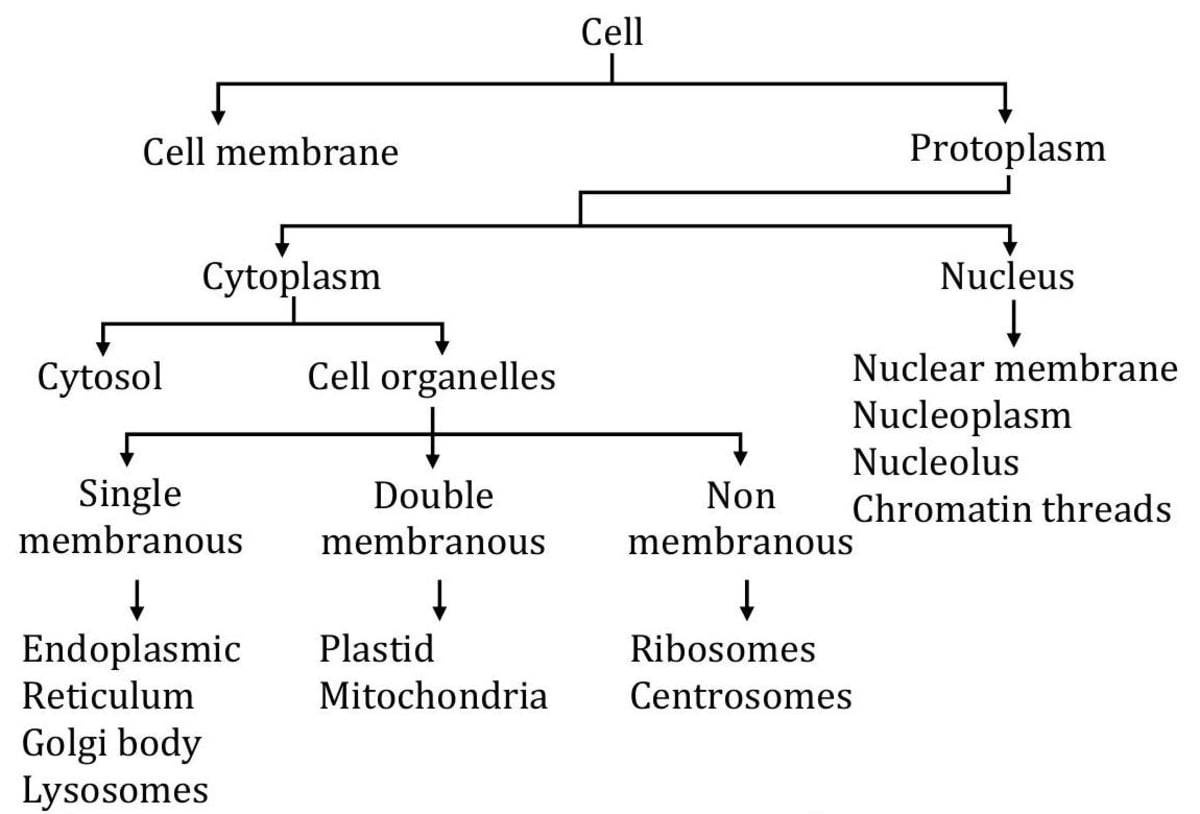
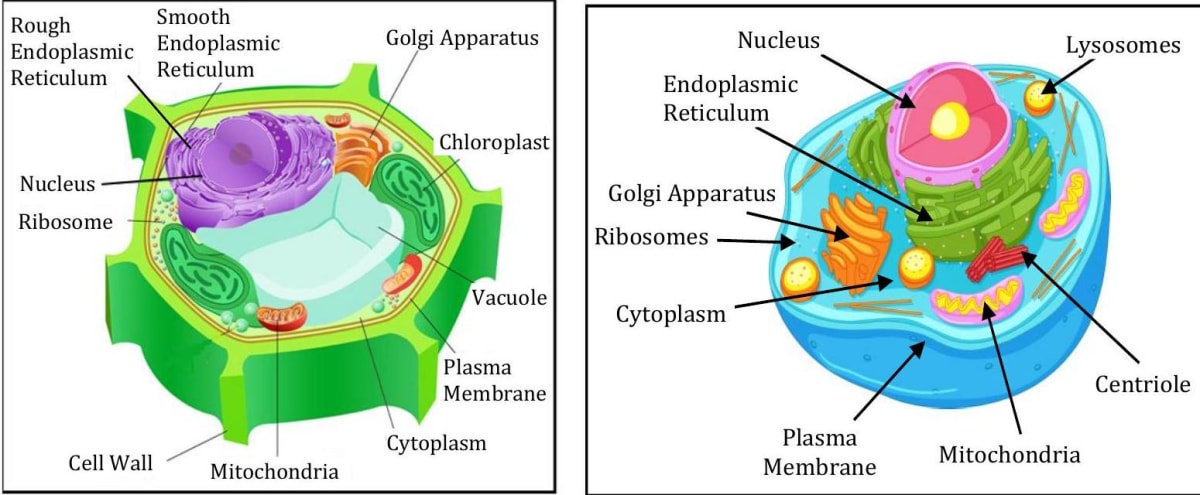
Plasma membrane or cell membrane or Plasmalemma All living cells, have a plasma membrane that encloses their contents. It is flexible and made up of organic molecules called lipids, proteins and small fraction of carbohydrates. Flexibility enables the cell to engulf in food and other materials (endocytosis). e.g. Amoeba. It serves as selectively permeable barrier to the outside environment. The plasma membrane is permeable to specific molecules, however, it allows nutrients and other essential elements to enter the cell and waste materials to leave the cell. Small molecules such as oxygen, carbon dioxide are able to pass freely across the membrane by diffusion but the passage of larger molecules, such as amino acids and sugars, is carefully regulated.
Plasma membrane is made of a bilayer of lipids (called phospholipids) and proteins. This structure was explained by Singer and Nicolson in the fluid mosaic model of plasma membrane.

Plasma membrane performs the following functions: (i) It protects the internal components of the cell. (ii) It provides shape to the cell. (iii) It allows materials to enter and leave the cell through the tiny holes called pores.
Note: Shrinking of protoplasm In plant cell plasmolysis In animal cell crenation
What is the role of membrane carbohydrates in cell recognition?
Short chains of sugars are linked to proteins and lipids on the exterior side of the plasma membrane, where they help in interaction with the surface molecules of other cells.
Transport across plasma membrane
In all living cells, substances may pass across the membrane with or without expenditure of energy. So, there are two types of transport: (1) Active transport: Transport of substances across plasma membrane against the concentration gradient with expenditure of energy is called active transport. (2) Passive transport: Transport of substances across plasma membrane along the concentration gradient i.e. from higher concentration to lower concentration without expenditure of energy is called passive transport.
Passive transport is of two types-
- Diffusion
- Osmosis
Diffusion
The process of movement of substances (solid, liquid & gas) from the region of its higher concentration to the region of its lower concentration to spread uniformly in the given space is called diffusion.
Diffusion Across Cell Membrane
Metabolic gases and move out and into the cells through diffusion. Respiration in cell produces carbon dioxide. As the concentration of (which is cellular waste) increases inside the cell as compared to the outside, diffuses out of the cell into the external medium. Similarly, concentration of oxygen is always higher in the external medium as compared to the cell where it is being consumed in respiration. Therefore, oxygen diffuses from outside to the inside of cell.
Osmosis
Osmosis is the net diffusion of water across a selectively permeable membrane towards a higher solute concentration.
Example of osmosis:
(i) Absorption of water by plant roots. (ii) Absorption of water by unicellular fresh water organisms.
Types of osmosis
Osmosis is of two types, endosmosis and exosmosis. Endosmosis is the osmotic entry of water into a cell or system. Exosmosis is the osmotic withdrawal of water from a cell or system.
The process of taking in a bulk of materials from external environment into the cell is known as endocytosis. It is of two types-Phagocytosis (cell eating) and Pinocytosis (cell drinking). Phagocytosis + Pinocytosis Endocytosis. SPOT LIGHT
Cell placed in solution
Plant and animal cells placed in salt or sugar solution will behave in one of the following ways depending upon the concentration of external solution.
- Hypotonic solution 99The external solution is dilute as compared to cell contents. It has more water content while the water content is lower inside the cell. The cell membrane allows passage of water in both direction. Due to difference in concentration of water molecules, there is net flow of water molecules into the cells. The phenomenon is called endosmosis.
- Isotonic solution
The external solution has the same concentration as that of the cell contents. Therefore, water content is equal on both sides. The amount of water going inside the cell is equal to the amount of water coming out of the cell. Therefore, there is no net movement of water. The cell size will remain the same.
Endosmosis
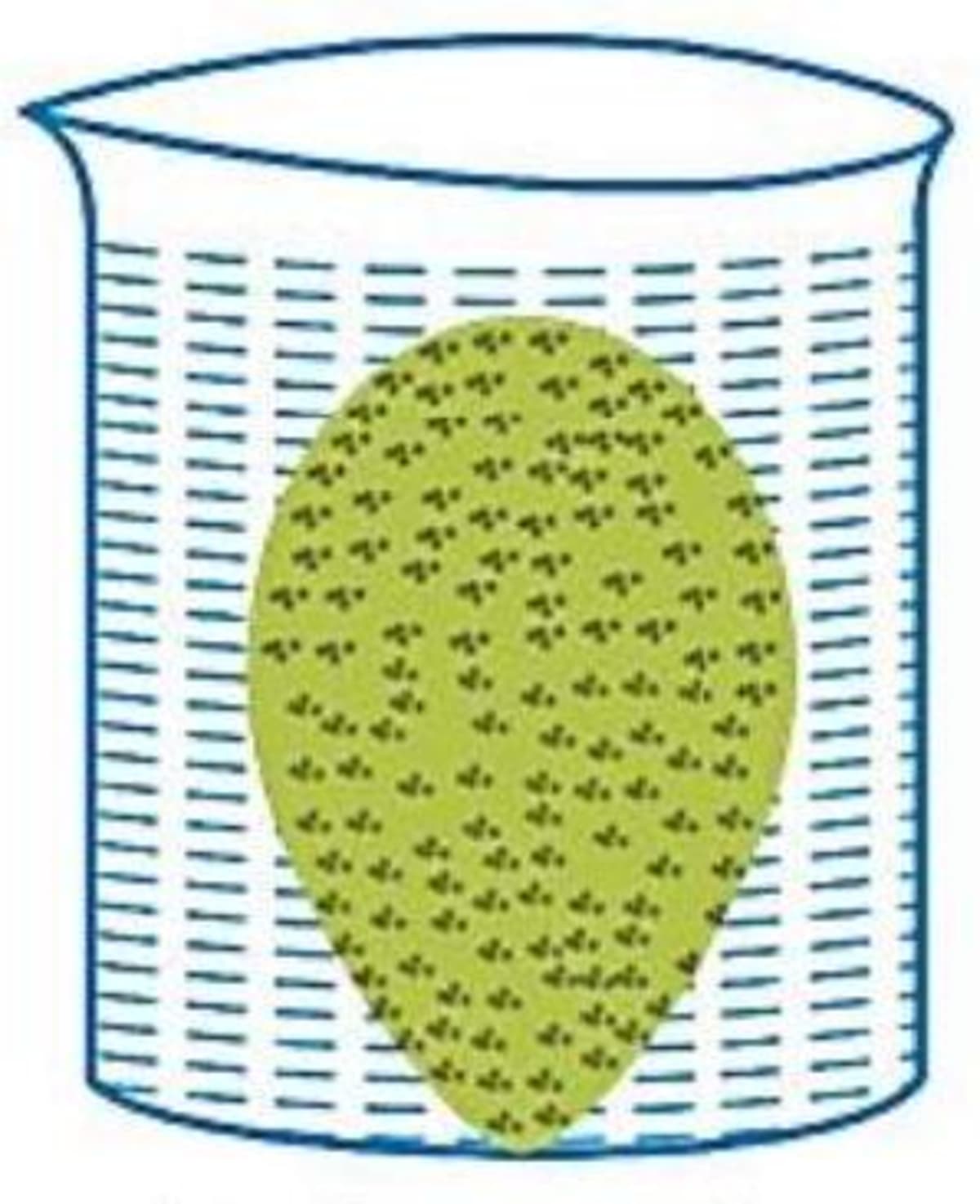 Exosmosis
Exosmosis
- Hypertonic solution
The external solution has more concentration as compared to that of cell. There is less concentration of water in the external solution than inside the cell. Since more water is present inside the cell, more of it will pass out. The phenomenon is called exosmosis.

(a) Normal cell placed in Isotonic solution (b )Normal cell placed in Hypotonic solution (c) Normal cell placed in Hypertonic solution
What will happen if both animal and plant cell are placed in hypotonic solutions?
It causes swelling of animal cell, due to swelling, animal cell bursts. Plant cell do not burst due to presence of cell wall.
What would happen if shelled raw egg and deshelled boiled egg are placed in water?
There will be no change in size of the egg. In case of raw egg, the shell acts as an impermeable covering and the boiled egg does not show any change as its membranous covering has become dead.
5.0Cell wall:
It is outermost rigid, freely permeable layer found outside the plasma membrane in all the plant cells, bacteria, blue-green algae, some protists and all fungi.
It is absent in animal cells. Cell wall permits the cells of plants, fungi and bacteria to withstand very dilute (hypotonic) external media without bursting. In such media the cells tend to take up water by osmosis. The cell swells, building up pressure against the cell wall. The wall exerts an equal pressure against the swollen cell. Because of their cell wall, such cells can withstand much greater changes in the surrounding medium than animal cells. When a living plant cell loses water through osmosis there is shrinkage or contraction of the contents of the cell away from the cell wall. This phenomenon is known as plasmolysis.
Structure and function
Cell wall of plant cells is formed of a fibrous polysaccharide called cellulose, while it is formed of peptidoglycan in bacteria and blue-green algae. It is formed of chitin in most of fungi. Cell wall is a protective and supportive coat. It also provides a definite shape to the cell.
Which of these is an essential component of cell, cell membrane or cell wall?
A cell can exist without cell wall like animal cell but cannot exist without cell membrane because cell is a tiny mass of protoplasm covered by plasma membrane.
6.0Nucleus (Headquarter of the cell)
- Discovered by - Robert Brown (1831)
"Nucleus is double membrane bound dense protoplasmic body, which controls all cellular metabolism and encloses the genetic information of cell". Nucleus is considered as controller or director of the cell. Structure: It is made up of following four components (a) Nuclear membrane/ Nuclear envelope/Karyotheca (b) Nuclear matrix/Nucleoplasm (c) Nucleolus (d) Chromatin threads (a) Nuclear envelope: Nucleus is surrounded by two membranes, that separates nucleoplasm from
Chromosomes are chemically made up of DNA and histone proteins. DNA carries all genetic information which is passed on to next generation. The functional segments of DNA are called genes.
SPOT LIGHT cytoplasm. The nuclear membrane has minute pores.

Functions of nucleus
The nucleus performs following functions: (1) It controls all the metabolic activities of the cell. (2) It brings about growth of the cell by directing the synthesis of structural proteins. (3) It takes part in the formation of ribosomes. (4) It regulates cell cycle. (5) It contains genetic information and is concerned with the transmission of hereditary traits from one generation to another. On the basis of the presence or absence of a well-developed nucleus, organisms can be of two types- (1) Prokaryotes: Organisms whose cells lack a nuclear membrane and the genetic material (DNA, RNA) lies freely in the form of nucleoid, are known as prokaryotes. e.g. Bacteria, blue green algae.
(2) Eukaryotes: Organisms whose cells have a well-organized nucleus with nuclear membrane are known as eukaryotes. e.g. All plant and animal cells.

Note: Prokaryotic cells also lack most of the other cytoplasmic organelles present in eukaryotic cells. Many of the functions of such organelles are also performed by poorly organised parts of the cytoplasm. The chlorophyll in photosynthetic prokaryotic bacteria is associated with membranous vesicles (bag like structures) but not with plastids as in eukaryotic cells.
7.0Cytoplasm
The fluid content inside the plasma membrane and excluding nucleus is called cytoplasm. Cytoplasm has cytosol and many cell organelles. Cytosol forms the aqueous, nearly transparent, structureless ground substance inside the cell. Cell organelles are sub-cellular structures which have characteristic form, structure and function. Almost all cell organelles are surrounded by membrane.
The significance of membrane can be illustrated with the example of virus. How?
Virus lack any membrane and hence do not show characteristics of life until they enter a living organism and use its cell machinery to multiply.
8.0Cell Organelles
Ribosomes (Engine of cell / Protein construction teams)
Ribosomes are smallest and membrane less cell organelles. They are composed `of RNA and proteins. It is also called organelle within an organelle and protein factory of cell. Ribosomes are also called the protein builders or the protein synthesizers of the cell. These proteins might be used as enzymes or as support for other cell functions.
Ribosomes are found in many places around the cell. They are floating in the cytoplasm. Those floating ribosomes make proteins that will be used inside the cell. Other ribosomes are found on the endoplasmic reticulum (rough endoplasmic reticulum). These attached ribosomes make proteins that will be used inside the cell and for export out of the cell. The 60S and 40S model works fine for eukaryotic cells. Prokaryotic cells have ribosomes made of 50 S and 30 S subunits.

Endoplasmic Reticulum
Structure:
Endoplasmic reticulum is a complex network of membrane bound channels or sheets, tubules and vesicles. It does not work alone. The ER works closely with the Golgi apparatus and ribosomes. It creates a network of membranes found through the whole cell. The ER may also look different from cell to cell, depending on the cell's function.
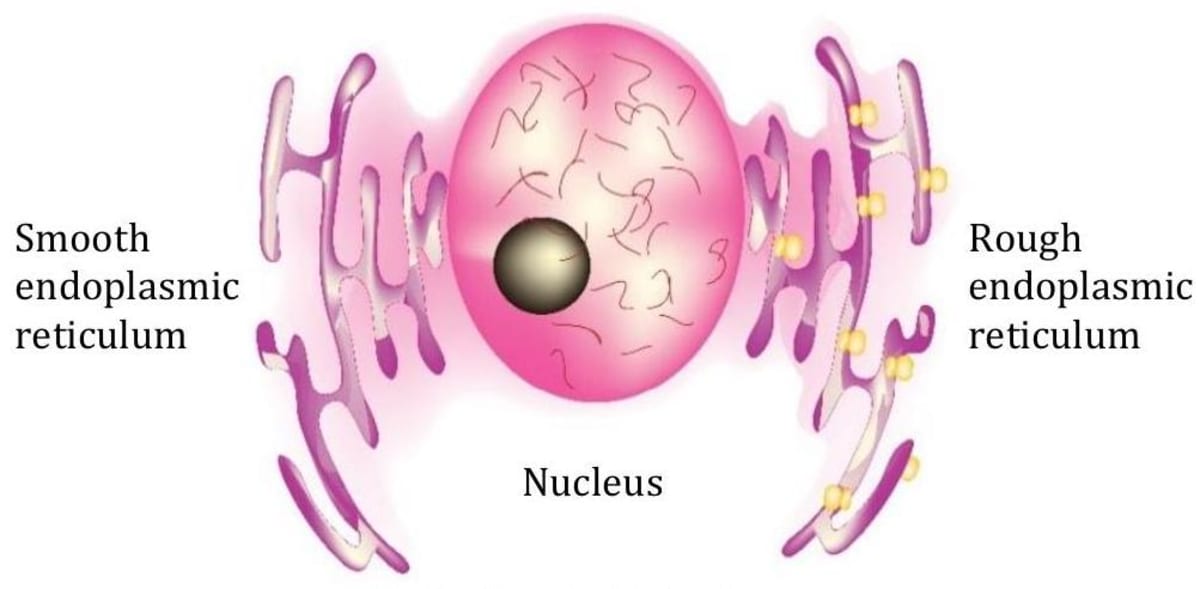
Components of E.R.
(i) Cisternae: These are long flattened and unbranched units arranged in stacks. (ii) Vesicles: These are oval membrane bound structures. (iii) Tubules: These are irregular, often branched tubes bounded by membrane. Tubules may be free or associated with cisternae.

Types of endoplasmic reticulum:
(i) Smooth ER/Agranular ER: It has smooth membranes which do not bear ribosomes. It acts as a storage organelle. It is important in the synthesis of lipids. They also store steroids. It is mainly made up of vesicles and tubules. (ii) Rough ER/Granular ER: It has rough membrane because a number of ribosomes are attached to its outer surface. RER is engaged in protein synthesis. It is mainly made up of cisternae. Tubules are very few.
Functions of endoplasmic reticulum
(i) ER serve as channels for the transport of materials (especially proteins) between various regions of cytoplasm or between cytoplasm and nucleus. (ii) It also functions as a cytoplasmic framework providing a surface for some of the biochemical activities of the cell. (iii) SER plays an important role in detoxifying many poisons and drugs and is also a site of lipid synthesis. (iv) RER is engaged in synthesizing proteins. (v) The proteins and lipids synthesized by RER and SER respectively help in building the cell membrane which is known as membrane biogenesis. Some of proteins and lipids formed by RER and SER functions as enzymes and hormones.
Golgi complex (Traffic police of cell)
Discovered by Camillo Golgi (1898) in nerve cells of owl. Golgi carried out a revolutionary method of staining individual nerve and cell structures. This method is referred to as "The black reaction". This method uses a weak solution of silver nitrate and is particularly valuable in tracing the processes and most delicate ramifications of cells. Golgi shared the Nobel prize in 1906 with Santiago Ramony Cajal for their work on tructure of nervous system. Position: It is located near the nucleus. Golgi bodies are pleomorphic structures, because components of Golgi body are different in structure and shape in different cells.
- The Golgi body has a definite polarity. Concave side of Golgi body is always directed towards the cell membrane and is called maturation face or trans face while its convex surface is directed towards the nucleus and is called formative face or cis face. It appears that materials are transported from cis to trans face by vesicles.
- Structure: It is formed of four types of structural components. (i) Cisternae: These are long flattened and unbranched saccules. 4 to 8 saccules are arranged in a stack. These are concentrically arranged near the nucleus. (ii) Tubules: These are branched and irregular tube-like structures associated with cisternae. (iii) Vacuoles: Large spherical structures associated to tubules. (iv) Vesicles: Spherical structures arise by budding from tubules. Vesicles are filled with secretory materials.

Function
(i) It is involved in cell secretion and acts as storage, modification and condensation or packaging membrane. (ii) It forms the acrosome of sperm. (Acrosome is a specialised vesicle present in the head of sperm filled with lytic enzymes which dissolve egg membrane at the time of fertilization.) (iii) It also involved in the formation of lysosomes and secretory vesicles. (iv) It is the site of formation of glycolipids and glycoproteins. (v) Synthesis of cell wall material (polysaccharide synthesis). (vi) Cell plate formation during plant cell division.
What would happen to the life of a cell if there was no Golgi apparatus?
There would be no lysosomes for intracellular digestion and cleaning, no complexing of molecules, no excretion and no formation of plasma membrane.
Lysosomes (Waste disposal system of the cell)
Lysosomes are spherical bag like structures covered by single membrane. Lysosomes hold enzymes that were created by the cell. The purpose of the lysosome is to keep the cell clean by digesting any foreign materials as well as worn-out cell organelles. They might be used to digest food or break down the cell when it dies.

A lysosome is basically specialized vesicle that holds a variety of hydrolytic enzymes. The enzyme proteins are first created in the rough endoplasmic reticulum. Those proteins are packaged in a vesicle and sent to the Golgi apparatus. The Golgi then does its final work to create the digestive enzymes and pinches it off in the form of small specific vesicle. That vesicle is a lysosome. From there, the lysosomes float in the cytoplasm until they are needed.
- Lysosomes are called digestive bags because they contain lots of digestive enzymes.
Why are lysosomes known as suicidal bags?
At the time of cellular damage, the lysosomes burst to release its enzyme and they digest its own cell. Therefore, lysosomes are also known as suicidal bags of a cell.
Mitochondria (Powerhouse of cell)
Mitochondria are double membrane bound organelles of eukaryotic cells.
Occurrence
These are found in all eukaryotic cells except mature mammalian RBCs. These are absent in prokaryotic cells.
Shape
The shape may be fibrillar, spherical (in yeast), oval, sausage shaped, discoidal or cylindrical.
Origin
Mitochondria have a small and circular chromosome, few RNA and 70S ribosome of their own and make some of their own proteins, showing that they were once aerobic bacteria.
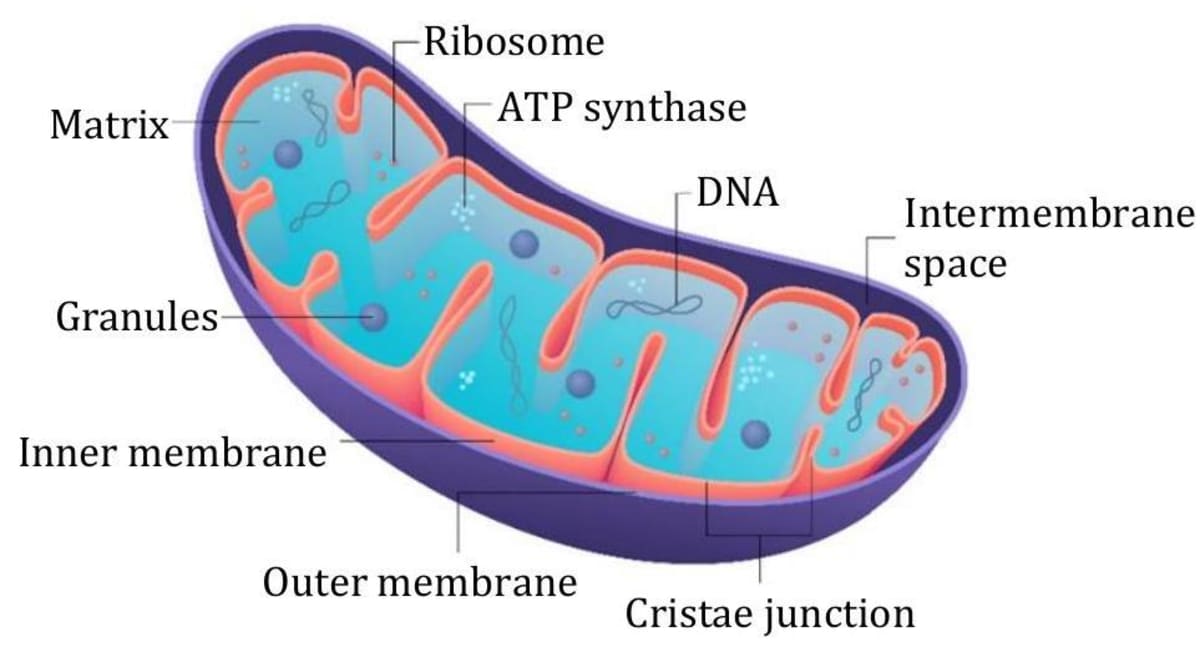
Structure
Mitochondria are selectively autonomous organelles bound by an envelope of two units membranes and filled with a fluid matrix. The outer membrane is smooth and has porous proteins which forms channels for the passage of molecules through it. The inner membrane usually produces numerous infolds called cristae. The cristae greatly increase the inner surface area of the mitochondria to hold a variety of enzymes. Cristae increases the surface area for ATP-generating chemical reaction. Cristae bear minute, regularly spaced tennis racket shaped particles known as particles or oxysomes. Oxysomes are concerned with ATP synthesis. Matrix contains various respiratory enzymes.
Function
Mitochondria are the main sites of cellular respiration. They bring about complete oxidation of food stuffs or respiratory substrates into carbon dioxide and water. They are commonly known as 'power house of the cell' because they contain enzymes necessary for the complete oxidation of food and for release of high amount of energy in the form of ATP (Adenosine triphosphate) molecules. The body uses energy stored in ATP for synthesis of new chemical compounds and for mechanical work. ATP is also known as energy currency of the cell.
Plastids
Plastids are major organelles found in the cells of plants and algae. Plastids are the site of manufacture and storage of important chemical compounds used by the cell. Plastids often contain pigments used in photosynthesis and the types of pigments present can change or determine the cell's colour. Plastids are responsible for photosynthesis, storage of products
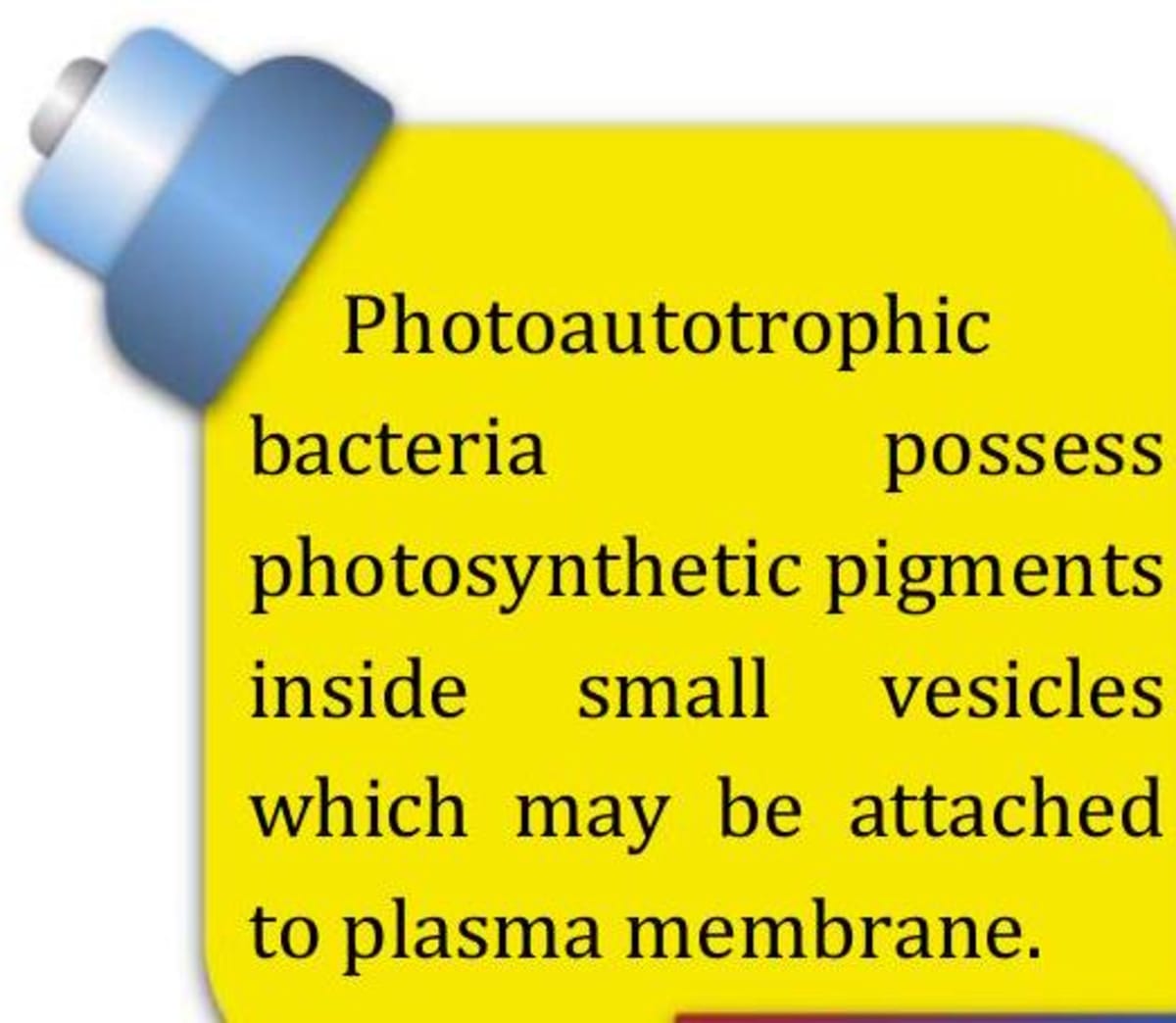
- Chromoplasts It is responsible for pigment synthesis and storage. Chromoplasts are red, yellow and orange in colour and are found in petals of flower and in fruits. Their colour is due to two pigments, carotene and xanthophyll.
- Leucoplasts Leucoplasts are colourless or white plastid. They occur in plant cell not exposed to light, such as roots and seeds. Leucoplasts are the centre of starch grain formation and they are also involved in the storge of oil, starch and proteins.
- Chloroplasts Chloroplasts are probably the most important among the plastids since they are directly involved in photosynthesis. They are usually situated near the surface of the cell and occur in those parts that receive sufficient light. e.g. the palisade cells of leaves. The green colour of chloroplasts is caused by the green pigment chlorophyll. It also contains various yellow-orange pigment in addition to chlorophyll.
Structure of chloroplast
Chloroplasts are usually disc-shaped and surrounded by a double membrane. Inside the inner membrane, there is a watery protein-rich ground substance called as stroma, in which, there is embedded a continuous membrane system, the granal network. This network forms a threedimensional arrangement of membrane bound vesicles called thylakoids. The thylakoids usually
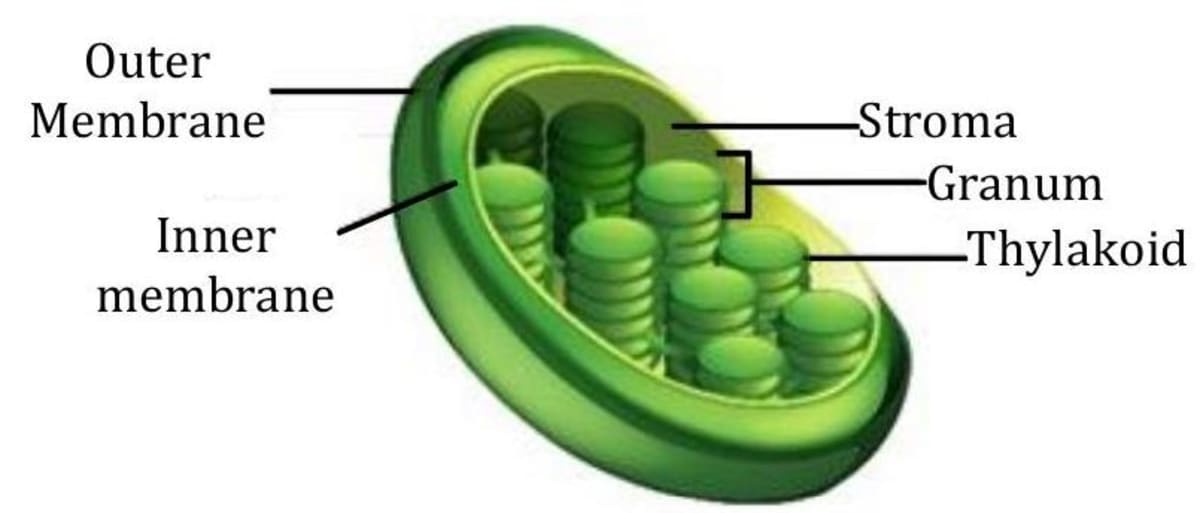
Chloroplast lie in stacks called grana and contain the photosynthetic pigments - green chlorophyll a and b and the yellow to red carotenoids. The grana are interconnected by tubular membranes called lamellae.
Function of Chloroplast
Chloroplasts are the sites of photosynthesis. They contain enzymes and coenzymes necessary for the process of photosynthesis.
Vacuoles:
Vacuoles are membrane bound storage sacs that contain nonliving liquid or solid contents.
In animal and young plant cells, vacuoles are small. In mature plant cells, there is a large central vacuole occupying 50-90% of cell volume and contain cell sap. The covering membrane of the vacuole is called tonoplast.

Functions
(i) In plant cell, vacuoles are full of cell sap and provide turgidity and rigidity to the cell. (ii) Vacuoles store amino acid, sugars, various organic acids and some proteins. (iii) They act as dump house for excretory products in plant cells.
Note: In single-celled organisms like Amoeba, the food vacuole contains the food items that the Amoeba has consumed. In some unicellular organisms, specialised vacuoles also play important roles in expelling excess water and some wastes from the cell.
Contractile vacuole in unicellular fresh water organisms take part in osmoregulation and excretion.
Comparison between Animal cell and Plant cell
9.0Cell division:

New cells are formed in organisms in order to grow, to replace old, dead and injured cells, and to form gametes required for reproduction. The process by which new cells are made is called cell division. There are two main types of cell division: mitosis and meiosis. The process of cell division by which most of the cells divide for growth is called mitosis. In this process, each cell called mother cell divides to form two identical daughter cells. The daughter cells have the same number of chromosomes as mother cell. It helps in growth and repair of tissues in organisms. Specific cells of reproductive organs or tissues in animals and plants divide to form gametes, which after fertilisation give rise to offspring. They divide by a different process called meiosis which involves two consecutive divisions. When a cell divides by meiosis it produces four new cells instead of just two. The new cells only have half the number of chromosomes than that of the mother cells. Note: Centrosome: Centrioles and centrosphere are collectively called centrosome. Two centrioles are located just outside the nucleus and lie at right angle . It initiates cell division by arranging spindle fibers between 2 poles of cell.
Comparison between Prokaryotes and Eukaryotes
10.0Biology Diagrams made Easy

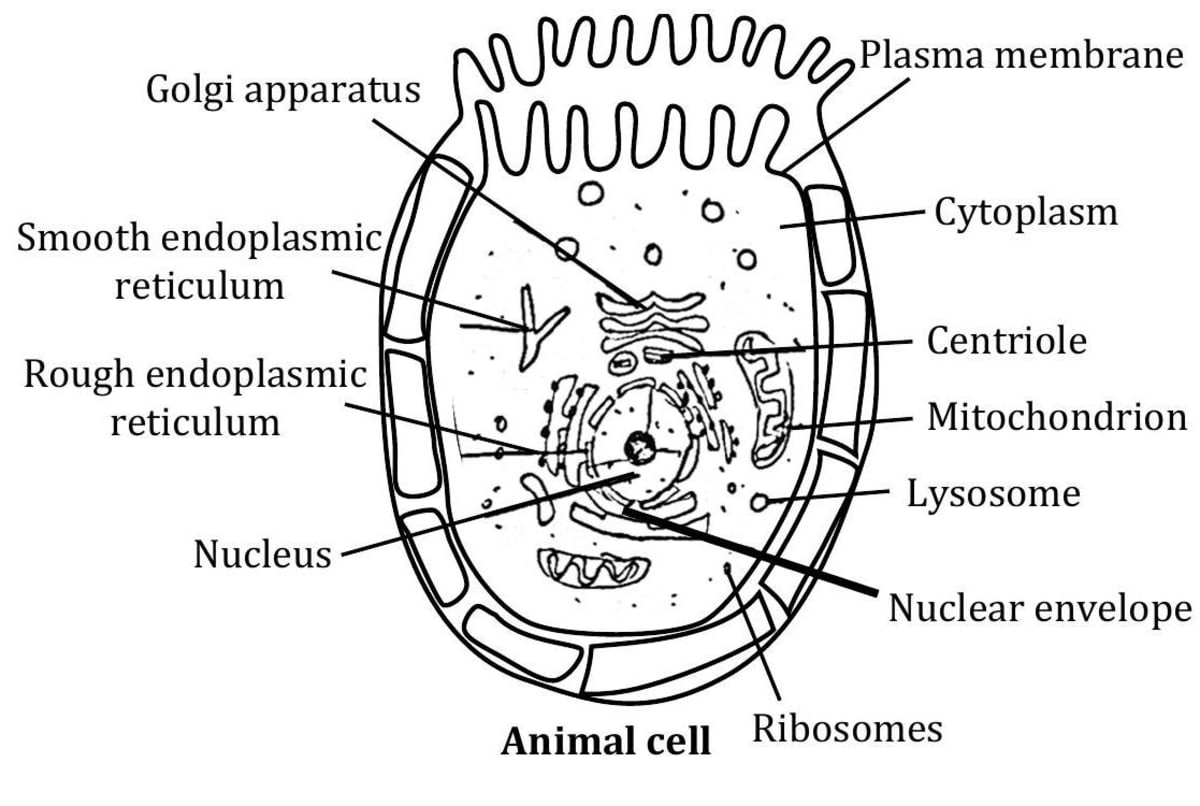
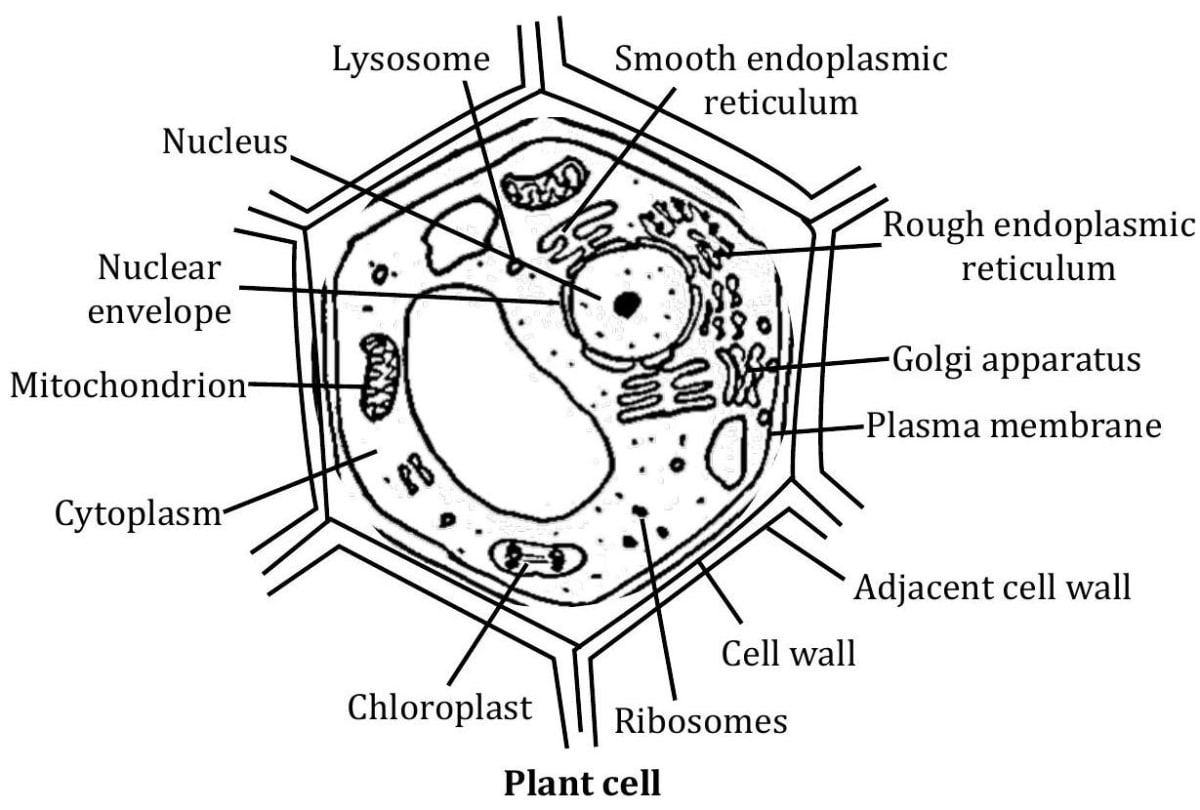
11.0Chapter At a Glance

12.0SOME BASIC TERMS
- Magnifying lens : Glass used to produce a bigger image of an object.
- Objective lens : Lens nearest to object.
- Eye piece : Lens nearest to eye.
- Petri dish : A covered dish that is not very deep.
- Periphery : The outer edge of particular area.
- Synthesized : Prepared
- Stack : A pile of something.
- Turgid : Swollen and distended.
- Permeable : Allowing a liquid or gas to pass.
- Biogenesis : The synthesis of chemical compounds or structures in the living organism.
- Prominent : Noticeable ; easy to see.
- Longitudinal : Running lengthwise.
- Mesophyll : Chlorophyll containing cells.
- Tendril : A long thin part that grows from a climbing plant for support.
- Leaf stalk : A thin long structure which attaches leaves to a stem.
- Epidermis : The surface epithelium of skin/outer layer of tissue in plant.
- Protoplasm : The fluid content of the cell inner to plasma membrane and including nucleus is called cytoplasm.
- Nucleoid : Irregularly shaped region in prokaryotic cell where genetic material is present.
- Tonoplast : Covering membrane of vacuole.
- Vesicle : Membraneous structure that stores cellular product.
Test your Knowledge
question 1 of 2
Which crucial discovery, made by Robert Brown in the year 1831, led to a better understanding of the cell’s control centre?
Related Article:-
Join ALLEN!
(Session 2026 - 27)